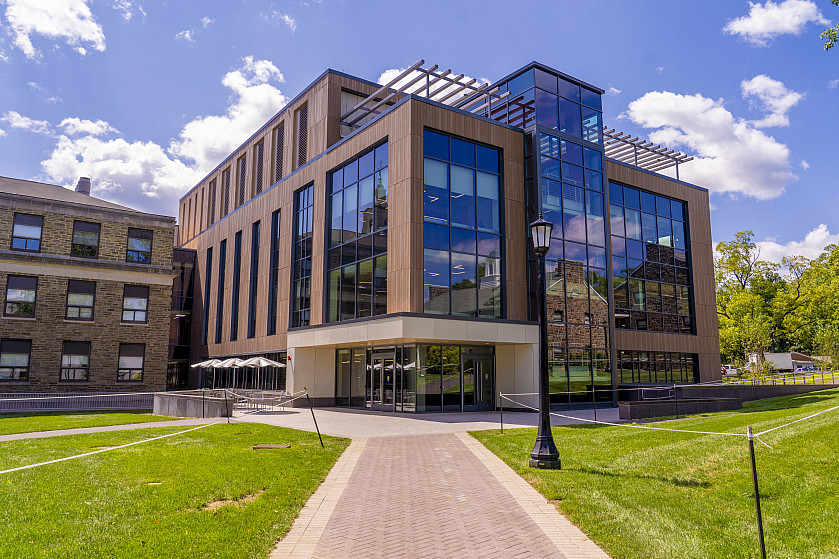
Research Labs & Resources
The Psychology and Neuroscience Departments have the following special labs and research resources:
Psychology Research Labs
The Social Psychology Laboratory
The Social Psychology Laboratory is located on the third floor of Thomas Hall, #308. This lab supports Dr. Mattingly’s research on relationships, the self, and social processes. The research suite is equipped with two cubicles and a one-way mirror that allows for unobtrusive observation. In addition, the laboratory utilizes various research software packages.
The Reinka Outcomes of Stigma Experiences (ROSE) Lab
The Reinka Outcomes of Stigma Experiences (ROSE) Lab is located on the third floor of Thomas Hall, #321. This lab supports Dr. Reinka’s research on stigma, stress, coping, and the health outcomes thereof. The research suite is equipped with multiple computer stations and physiological measurement capabilities.
Psychology Research Lab Resources
BIOPAC is a customizable psychophysiological measurement system. The ROSE lab is able to measure cardiac responses using EKG, HRV, and impedance cardiography.
E-Prime is a behavioral research presentation software used to run in-lab experiments. Primarily used as a stimulus presentation software, E-Prime can also be used to collect self-report data, and can be integrated with BIOPAC software for accurate psychophysiological response analysis.
Inquisit (by Millisecond) is a software package that allows psychologists to create and administer a wide range of computer-based experiments. Most common to social psychological research, this program allows for reaction time measurements, subliminal priming, tests of implicit associations, and manipulations of social inclusion, just to name a few.
Linguistic Inquiry and Word Count (LIWC) is a text analysis software package that quantitatively analyzes the degree to which people use different categories of words, such as emotional valenced and self-referent words. The program quickly and efficiently assists researchers in coding open-response text for key constructs.
Neurobehavioral Testing Suite
The Neurobehavioral testing suite is located on the bottom floor of the Innovation and Discovery Center (IDC) and is shared by faculty in Neuroscience, Psychology, Biology, and Health and Exercise Physiology (HEP). This research suite has equipment for testing anxiety-like behavior, learning and memory, social behavior, and sensorimotor function in rodents. The Noldus Ethovision XT automated animal behavior tracking system is installed in the neurobehavioral testing suite and can be used in conjunction with most behavioral apparatuses.
The elevated plus maze and open field arena are both used to assess anxiety-like behaviors in rodents and are the gold standards (Carola et al. 2002) for these assessments.
The Barnes maze and 8-arm radial arm maze can be used to examine spatial memory and navigation and reference and working memory, respectively, in mice.
The three-chambered sociability and social memory apparatus is used to investigate sociability and social novelty preference in rodents.
The SR-LAB startle response system can be used to assess the startle reflex, modulation of reflexive responses by non-associative learning mechanisms, and pre-pulse inhibition in mice. This system examines sensorimotor processing and function and is fully automated for precise data collection. The rotarod system exploits the natural fear of falling to assess motor coordination, balance, and motor learning in up to four mice simultaneously, and data collection is fully automated.
Neuroscience Research Labs
The Neuroscience Laboratories are located on the third floor of Thomas Hall, #307,
Dr. Bish and Dr. Frymiare share a cognitive neuroscience research suite that houses electroencephalography, eye-tracking, optical imaging, and language processing equipment.
Neuroscience Research Lab Resources
The CURRY Scan NuAmps Express by Neuroscan is a digital EEG and ERP recording system comprising a 40 channel NuAmps amplifier, fitted electrode caps and individual electrodes, and the CURRY Neuroimaging acquisition and analysis software.
The Tobii T60 eye-tracking system features an eye-tracker integrated in a 17inch TFT monitor, Tobii Studio Professional software, and E-Prime Extensions for Tobii. The Tobii system enables on-screen eye tracking with a large degree of head movement suitable for research with children or adults. Furthermore, the Tobii system can be used in conjunction with the Neuroscan system for simultaneous collection of EEG/ERP and eye-tracking data.
The Biopac Functional Near Infrared Brain Imaging System (fNIR) features an fNIR sensor that research participants wear on their forehead to detects neural activity and hemodynamic response in the prefrontal cortex while the participant completes the research study (e.g., performs a computer task). The package also includes fNIRSoft software for data viewing and analysis. fNIR data acquisition can be combined with other physiological measures such as EEG.
The LENA language processing system includes two digital language processors (DLPs) and the LENA Pro software. Collectively, the LENA system permits relatively automatic assessment of children’s natural language environment.